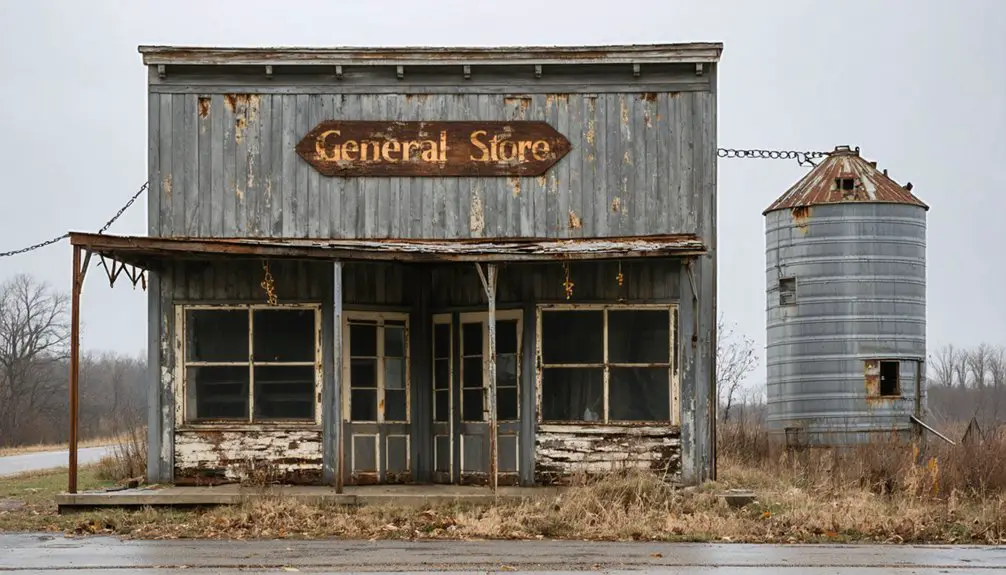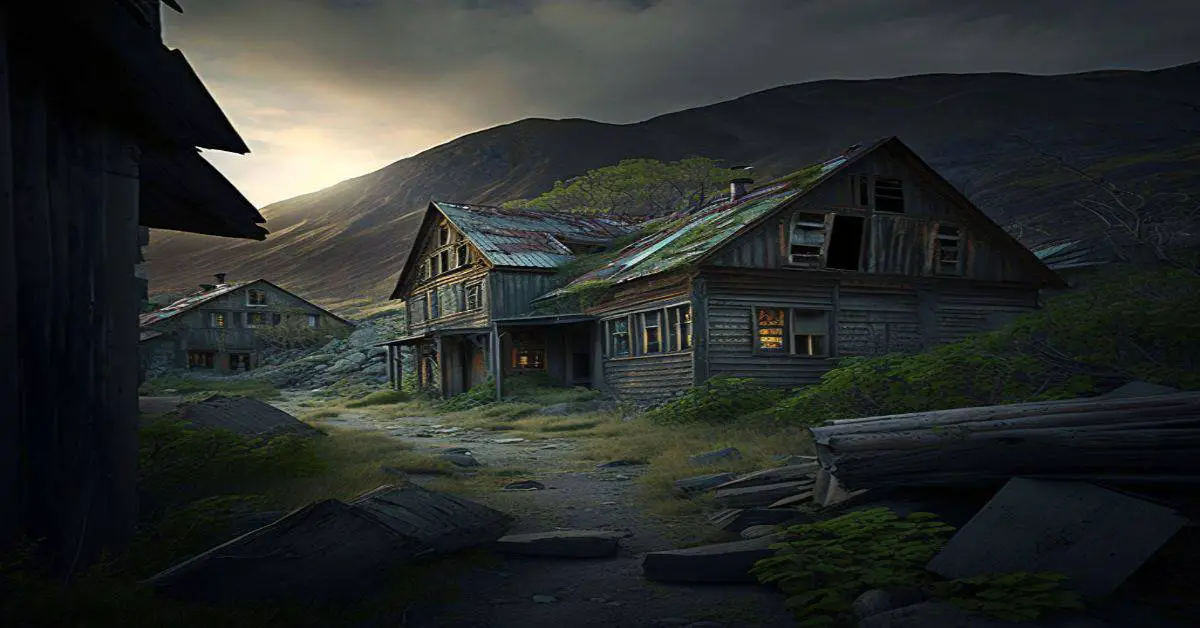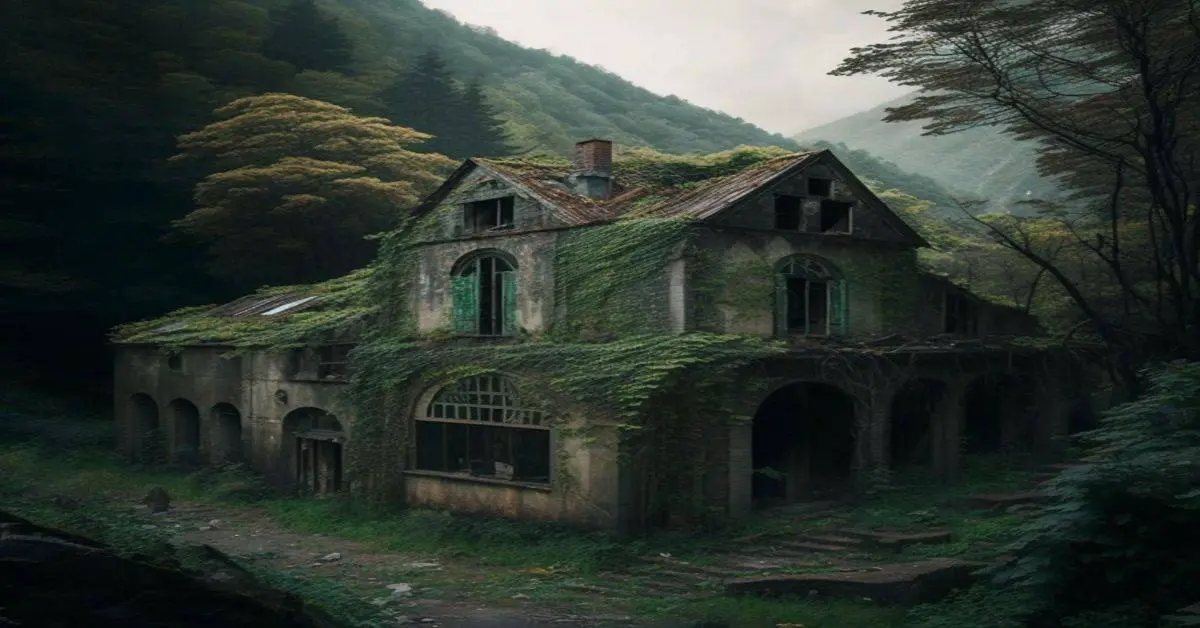You’ll find Dighton as a ghost town in Michigan’s Osceola County, where a once-thriving lumber community peaked at 1,000 residents in the 1880s. The town emerged around three major sawmills and the Manistee & Grand Rapids Railroad, which arrived in 1901. While most buildings are gone, you can still spot the historic David Family Store from 1887 and traces of its rowdy past, when bootlegging and lumber mill life defined this northern frontier settlement.
Key Takeaways
- Dighton transformed from a bustling lumber town of 1,000 residents in the 1880s to a ghost town following timber depletion by 1910.
- The town’s decline directly resulted from the exhaustion of Michigan’s timber resources and subsequent closure of three major sawmills.
- Only the historic Dighton General Store from 1887 remains as a significant landmark among abandoned buildings and old foundations.
- Railroad infrastructure, which once made Dighton a transportation hub, now stands abandoned with remnants of the old station still visible.
- The community’s swift downfall exemplifies the boom-and-bust cycle of Michigan’s lumber towns in the late 19th and early 20th centuries.
The Birth of a Lumber Town
When lumber pioneers first surveyed Michigan’s Osceola County in the late 19th century, they discovered an area ripe for development that would soon become Dighton.
Originally called Rolfe, the village was renamed to honor early settler Dighton Marvin, known locally as “Dight.” His pioneer spirit helped establish what would become a thriving lumber legacy. The town’s earliest days were marked by wild frontier events, including a murder in 1868 and the burning of a local dance hall.
At its peak in the 1880s, the village supported three major sawmills and reached a population of nearly 1,000 residents.
Railroad’s Arrival and Economic Boom
You’ll find Dighton’s transformation began in 1901 when the Manistee & Grand Rapids Railroad established its presence, prompting the town’s relocation and spurring rapid development.
The railroad’s arrival turned Dighton into a bustling transportation hub, supporting three lumber mills and multiple general stores including the Victor Rolfe and David Family establishments. Located seven miles east of Tustin, Dighton’s strategic position enhanced its role in regional commerce. Similar to the nearby town of Orono, the area featured wild brawls and bootlegging activity during its peak years.
With improved rail connectivity, Dighton’s population swelled to 1,000 residents as the town became an integral part of Michigan’s expanding rail network, linking its lumber industry to broader regional markets.
Railroad Construction Timeline
The arrival of the Michigan East and West Railroad in 1884 marked Dighton’s establishment as an essential transportation hub in Osceola County. The railroad’s construction followed major railroad milestones in Michigan that began as early as 1836, when the state government provided substantial loans to stimulate rail development throughout the region. State ownership of early rail lines later proved financially unsustainable, leading to their sale to private companies. You’ll find that construction challenges didn’t stop the line’s steady progress, as crews laid tracks strategically to connect towns spaced five to seven miles apart. The railroad’s phased construction allowed for partial operations to begin generating revenue from both freight and passenger services. Similar to the Old Colony Railroad, the line played a crucial role in connecting regional communities and fostering economic growth through enhanced transportation networks.
Economic Growth Patterns
Following the Michigan East and West Railroad’s arrival in 1884, Dighton’s transformative growth accelerated dramatically with the Manistee & Grand Rapids Railroad’s completion in 1901.
The town quickly expanded with three lumber mills forming its industrial core, while supporting businesses like general stores, a telephone company, and a stagecoach stop emerged to serve the growing population. The town was proudly named after Dighton Marvin. Like many Michigan settlements, this resource-based community relied heavily on its natural assets.
You’ll find that the town’s population surged to 1,000 as the lumber industry boomed, creating an economic dependency on timber resources that would define the community’s fate.
You can trace how this rapid development relied entirely on resource sustainability – or lack thereof.
Transportation Hub Development
While Michigan’s early railroad development gained momentum in the 1830s with the Erie & Kalamazoo line, Dighton’s strategic position wouldn’t emerge until decades later through concentrated rail expansion efforts.
You’ll find that the transportation evolution in this region aligned with Michigan’s broader rail development, which saw over 180 years of expansion and connectivity improvements.
As part of the Flint & Pere Marquette Railway‘s growth, which by 1899 operated more than 700 miles of track, Dighton gained significance through enhanced rail connectivity. The railway’s development was supported by a $3,775,000 land grant from the federal government in 1856. Michigan’s dynamic railroad landscape included the arrival of Michigan Central Railroad, which further expanded regional transportation options.
The area benefited from the railroad’s extensive land grants and strategic positioning within Michigan’s expanding rail network. This infrastructure boom connected Dighton to major industrial centers, creating crucial links to Chicago and Buffalo, while supporting the movement of timber, agricultural products, and manufactured goods.
Daily Life in Early Dighton
If you’d lived in early Dighton, you’d have found yourself traversing washboard dirt roads to reach scattered homes, many of which left only their foundations as evidence today.
Your workday might’ve centered around one of the town’s three bustling sawmills, where the constant whir of machinery processing Michigan timber defined the economic pulse of the community.
After hours, you could’ve joined fellow residents at the upstairs dance halls, though these gatherings earned a reputation for their rowdy nature and occasional violent outbursts.
Homes and Living Conditions
Life in early Dighton centered around modest wooden homes that reflected the town’s lumber-based economy. You’d find these housing styles clustered near the mill and railroad, where workers needed quick access to their jobs.
Living conditions were basic – you’d light your home with kerosene lamps and rely on wood stoves for heat and cooking. Most homes lacked indoor plumbing, so you’d fetch water from rivers or wells for daily needs.
Space was at a premium in these simple rectangular structures with gable roofs. You’d likely share your home with extended family or even boarders, making every room serve multiple purposes.
While the accommodations were sparse by today’s standards, your home would’ve been a hub of activity, hosting informal gatherings with neighbors and serving as a refuge from the demanding work of frontier life.
Work at the Mill
The daily rhythms of Dighton revolved around its bustling mill operations, where you’d find workers streaming in at dawn to begin their demanding shifts.
You’d spend your days in a vast, open room filled with the constant roar of machinery, coordinating with fellow millworkers to process “Snow Flake” flour and lumber products. The mill’s output of 75 barrels of flour per day kept you constantly moving.
As a skilled worker, you’d navigate the dangers of operating heavy milling equipment and saws, battling the persistent dust and noise. The work wasn’t easy, but it provided steady employment that supported Dighton’s population of over 1,000 residents.
Unfortunately, by 1910, you’d witness the decline as timber supplies dwindled, eventually leading to the devastating fires that marked the end of mill life.
Social Gatherings and Entertainment
During Dighton’s heyday, you’d find entertainment centered around the town’s vibrant dance halls, where revelry often turned rowdy as settlers sought escape from their arduous mill work.
Dance hall incidents, fueled by bootlegged alcohol, frequently erupted into brawls, with men sometimes getting thrown from upper floors during heated altercations.
You could join your neighbors at Gibson’s drugstore or the three-story schoolhouse for community storytelling and social gatherings.
The Swedish Evangelical Church organized events that helped integrate immigrant families while preserving their cultural traditions.
The Dighton General Store served as a late-stage meeting spot where locals exchanged news and stories.
Despite the occasional violence and racial tensions that plagued the frontier town, these venues provided essential spaces for settlers to build connections and find respite from their daily struggles.
The Wild Side of the Wild North
While northern Michigan towns often carried a quaint reputation, Dighton emerged as a notoriously lawless frontier settlement in the early 1900s.
You’d find drunken brawls erupting regularly in the streets, and men being thrown from upstairs dance halls. The town’s lawlessness legacy included bootlegging operations during Prohibition and violent racial tensions that culminated in murder plots against black settlers.
Despite being far from the traditional Wild West, Dighton embodied the same untamed spirit.
The flood of transient laborers drawn by railroad and lumber jobs created a volatile atmosphere where violence ruled the day.
Even as the town boomed to 1,000 residents, it maintained its reputation as one of Michigan’s most dangerous settlements, where outlaws found refuge and chaos reigned supreme.
Swedish Immigration and Cultural Impact
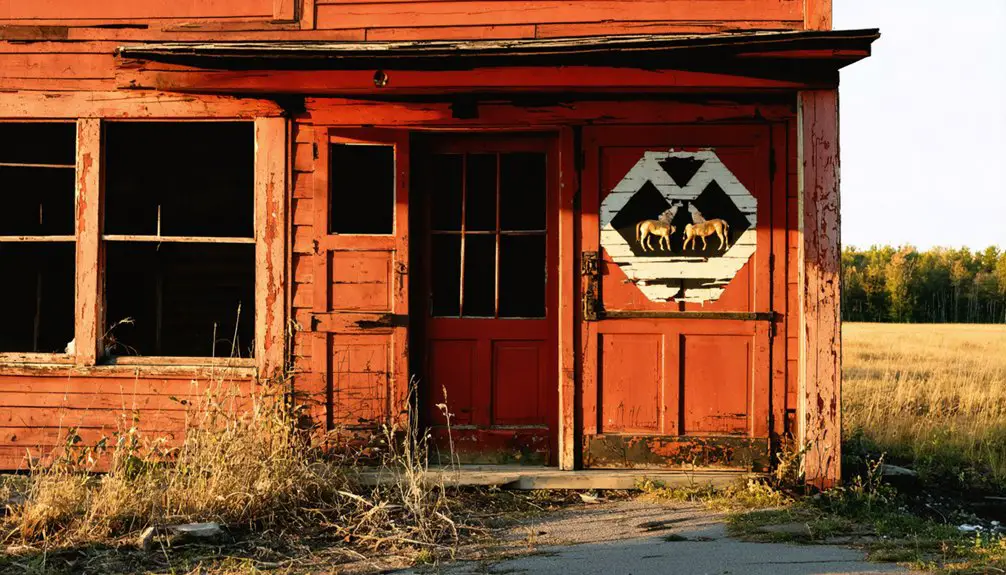
Seeking economic opportunities rather than religious freedom, Swedish immigrants began flooding into Michigan during the late 19th century, fundamentally reshaping the state’s cultural landscape.
You’ll find their influence was especially strong in the Upper Peninsula, where they worked in mining and timber industries while establishing tight-knit communities.
These immigrants didn’t just bring their labor – they created a rich cultural tapestry through their Lutheran churches, social clubs, and Swedish-language newspapers.
They’d gather for cultural festivals celebrating their heritage, complete with traditional singing and dancing.
While first-generation Swedes held onto their native tongue, their children often became bilingual, bridging old and new worlds.
Through determined persistence, they built lasting neighborhoods and institutions that’d shape Michigan’s character for generations to come.
Rise and Fall of the Timber Industry
From humble beginnings in the 1840s, Michigan’s timber industry exploded into a powerhouse that would dominate the nation’s lumber production for three decades.
You’d have found the Saginaw Valley leading this transformation, where lumber production soared from $1 million to $6 million annually between 1840 and 1860.
The boom didn’t last forever, though. Despite New England lumbermen’s expectations that Michigan’s vast white pine forests would sustain the industry for a century, aggressive clear-cutting led to rapid timber depletion by the 1890s.
Michigan’s timber empire crumbled in the 1890s, as rampant clear-cutting depleted forests that were expected to last generations.
Towns like Dighton felt the devastating impact when their timber ran out by 1910, triggering severe economic decline. As mills closed and railroad lines were abandoned, once-thriving communities shrank or became ghost towns, leaving only overgrown streets and scattered remnants of their logging heritage.
Notable Buildings and Landmarks
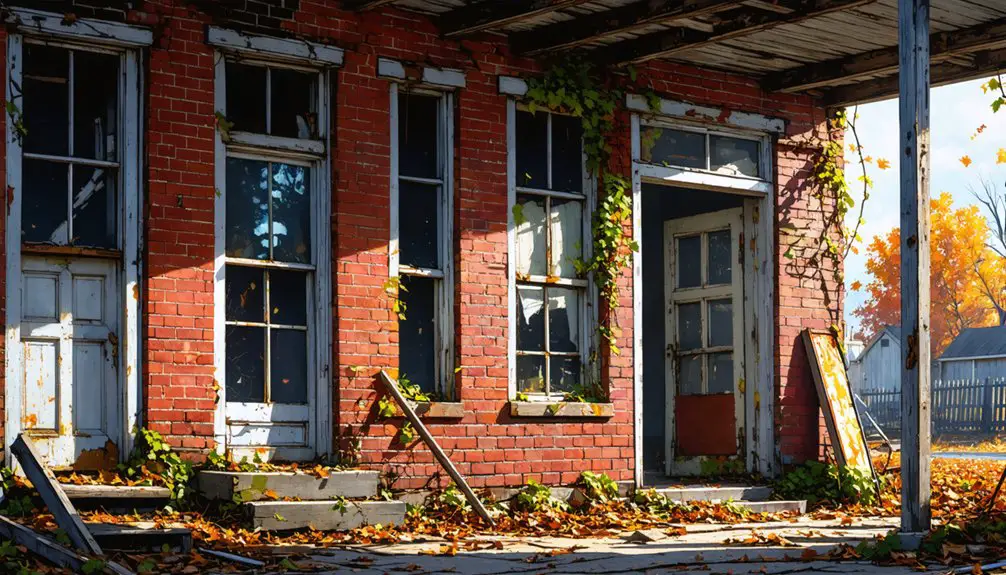
Today in Dighton, you’ll find only scattered remnants of what was once a bustling lumber town, with the David Family Store of 1887 (now known as the Dighton General Store) standing as its most prominent survivor.
The abandoned buildings and structural remains tell a story of historical significance, from the old railroad station that once connected the region to the deteriorating Jacobs general stores on 130th Avenue.
- Victor Rolfe General Store stands empty but intact, a reflection of the town’s commercial past
- One-room schoolhouse remains as a symbol of frontier education
- Old foundation marks Dighton’s original location, about a mile northeast on 20 Mile Road
- Former church sites reveal the community’s religious heritage
- Railroad station remnants hint at the town’s vital role in Michigan’s lumber era
Following the Ghost Town Trail
While the historic buildings of Dighton tell their own stories, exploring the broader Ghost Town Trail offers visitors a deeper look into Michigan’s vanished communities.
You’ll find that careful historical documentation guides your journey through these abandoned settlements, though many locations require strategic planning to access due to rough terrain and washboard dirt roads.
To make the most of your ghost town preservation exploration, you’ll want to approach some sites from alternative routes.
Consider exploring alternate access points to ghost town sites for better preservation opportunities and easier navigation.
While traveling the trail, you can discover old foundations, interpretive markers, and places where nature has reclaimed former townsites.
Local historical groups provide detailed maps and notes to help navigate between sites.
Remember that many ghost town locations sit on private property, so always respect posted boundaries and restrictions.
Preserving Dighton’s Legacy
Despite its physical deterioration, Dighton’s legacy as a once-thriving lumber town endures through scattered remnants and cultural memory.
Through historical storytelling, you’ll discover how Swedish immigrants built a vibrant community around the lumber industry in the 1870s. While formal preservation efforts remain limited, community engagement keeps Dighton’s story alive through online platforms and local historians.
- Old foundation stones marking the original settlement on 20 Mile Road
- Weather-worn remains of the Dighton General Store
- Historic intersection at 130th Avenue and 19 Mile Road
- Documentation of the town’s three sawmills and three-story schoolhouse
- Preserved photographs and oral histories from descendants
You’ll find Dighton’s heritage maintained not through restored buildings, but through the passionate sharing of stories by those who understand its significance to Michigan’s development.
Frequently Asked Questions
Are There Any Known Buried Treasures or Artifacts in Dighton?
All that glitters isn’t gold – you won’t find documented buried artifacts or treasure legends here. Historical records show no verified discoveries, though lumber and railroad remnants might hide everyday historical items.
What Happened to the Families Who Lived There After 1955?
You’ll find most families relocated to Cadillac, just 12 miles north, seeking better opportunities. They carried their community memories while dispersing throughout Michigan, maintaining ties through occasional visits and shared stories.
Does Anyone Still Live Within Dighton’s Original Town Boundaries Today?
You won’t find any current residents within the original town boundaries. The area that once bustled with life during its peak has become a true ghost town, preserving only remnants of its history.
Were There Any Notable Crimes That Remained Unsolved in Dighton?
You’d think a rough logging town would’ve left us juicier unsolved mysteries, but beyond some window-tossing brawls and a racially-motivated murder plot, Dighton’s local legends stay pretty quiet on documented crimes.
Is There a Cemetery, and Where Were Dighton’s Residents Typically Buried?
You won’t find a dedicated cemetery in the town itself. Local burial traditions directed residents to nearby community cemeteries, township grounds, or small family plots throughout Osceola County instead.
References
- https://99wfmk.com/dighton-michigan/
- https://www.nailhed.com/2016/09/dawn-patrol.html
- https://www.geocaching.com/geocache/GC1BHNQ
- https://99wfmk.com/michigan-ghost-town-gallery/
- https://www.bigrapidsnews.com/news/article/michigan-ghost-town-dighton-wild-side-18376535.php
- https://witl.com/lumber-camps/
- https://www.instagram.com/p/C3wIJW5sp_9/
- https://www.michigan.gov/-/media/Project/Websites/MDOT/Travel/Mobility/Rail/Michigan-Railroad-History.pdf?rev=39dfdb4445e04a87916419fc13937dd2
- https://michiganrailroads.com/stations-locations/131-osceola-county-67/1695-dighton-mi
- https://www.bigrapidsnews.com/news/article/michigan-ghost-towns-school-project-kept-orono-18684837.php
